Growth and Characterization of High Doping Concentration (2.1 at%) Ytterbium (Yb) Doped Lithium Niobate (LiNbO3) Crystal: An Electrically Tunable Lasing Medium
Abstract
1. Introduction
2. Materials and Methods
3. Results and Characterization
3.1. Picture of the Grown Yb:LiNbO3 Sample
3.2. Measure the Density of the Grown Yb:LiNbO3 Sample
3.3. Determine the Material Composition of the Grown Yb:LiNbO3 Sample
3.4. Determine the Crystalline Structure of the Grown Yb:LiNbO3 Sample
3.5. Measure the Absorption and Emission Spectra of the Grown Yb:LiNbO3 Bar Sample
3.6. Investigate the Electro-Optic Effect of the Grown Yb:LiNbO3 Crystal Sample
4. Discussion
5. Conclusions
Author Contributions
Funding
Informed Consent Statement
Data Availability Statement
Conflicts of Interest
References
- Duarte, F.J. Tunable Laser Applications, 3rd ed.; CRC Press: Boca Raton, FL, USA, 2016; pp. 1–428. [Google Scholar]
- Ren, Y.; Xiong, B.; Yu, Y.; Lou, K.; Chu, T. Widely and fast tunable external cavity laser on the thin film lithium niobate platform. Opt. Commun. 2024, 559, 130415. [Google Scholar] [CrossRef]
- Pisarski, W.A. Rare earth doped glasses/ceramics: Synthesis, structure, properties and their optical applications. Materials 2022, 15, 8099. [Google Scholar] [CrossRef] [PubMed]
- Brenier, A.; Boulon, G. Overview of the best Yb3+-doped laser crystals. J. Alloy Compd. 2001, 323–324, 210–213. [Google Scholar] [CrossRef]
- Huang, Q.; Fang, Z.; Wang, Z.; Zhu, Y.; Liu, J.; Zhou, Y.; Yu, J.; Wang, M.; Cheng, Y. On-chip tunable single-mode high-power narrow-linewidth Fabry–Perot microcavity laser on Yb3+-doped thin-film lithium niobate. Photon. Res. 2025, 13, 935–940. [Google Scholar] [CrossRef]
- Liu, X.; Chen, C.; Ge, R.; Wu, J.; Chen, X.; Chen, Y. Ultralow-Threshold Lithium Niobate Photonic Crystal Nanocavity Laser. Nano Lett. 2025, 25, 6454–6460. [Google Scholar] [CrossRef]
- Zhu, D.; Shao, L.; Yu, M.; Cheng, R.; Desiatov, B.; Xin, C.; Hu, Y.; Holzgrafe, J.; Ghosh, S.; Shams-Ansari, A.; et al. Integrated photonics on thin-film lithium niobate. Adv. Opt. Photon. 2021, 13, 242–352. [Google Scholar] [CrossRef]
- Luo, Q.; Yang, C.; Hao, Z.; Zhang, R.; Ma, R.; Zheng, D.; Liu, H.; Yu, X.; Gao, F.; Bo, F.; et al. Integrated ytterbium-doped lithium niobate microring lasers. Opt. Lett. 2022, 47, 1427–1430. [Google Scholar] [CrossRef]
- Guo, Q.; Gutierrez, B.; Sekine, R.; Gray, R.; Williams, J.; Ledezma, L.; Costa, L.; Roy, A.; Zhou, S.; Liu, M.; et al. Ultrafast Mode-Locked Laser in Nanophotonic Lithium Niobate. Science 2023, 382, 708–713. [Google Scholar] [CrossRef]
- Bredillet, K.; Riporto, F.; Guo, T.; Dhouib, A.; Multian, V.; Monnier, V.; Figueras Llussà, P.; Beauquis, S.; Bonacina, L.; Mugnier, Y.; et al. Dual second harmonic generation and up-conversion photoluminescence emission in highly-optimized LiNbO3 nanocrystals doped and co-doped with Er3+ and Yb3+. Nanoscale 2024, 16, 6739–6747. [Google Scholar] [CrossRef]
- Palatnikov, M.N.; Kadetova, A.V.; Aleshina, L.A.; Sidorova, O.V.; Sidorove, N.V.; Biryukova, L.V.; Makarova, O.V. Growth, structure, physical and chemical characteristics in a series of LiNbO3:Er crystals of different composition grown in one technological cycle. Opt. Laser Technol. 2022, 147, 107671. [Google Scholar] [CrossRef]
- Bruesselbach, H.; Sumida, D.S. A 2.65-kW Yb:YAG single-rod laser. IEEE J. Sel. Top. Quantum Electron. 2005, 11, 600–603. [Google Scholar] [CrossRef]
- Yoshikawa, A.; Boulon, G.; Laversenne, L.; Canibano, H.; Lebbou, K.; Collombet, A.; Guyot, Y.; Fukuda, T. Growth and spectroscopic analysis of Yb3+-doped Y3Al5O12 fiber single crystals. J. Appl. Phys. 2003, 94, 5479–5488. [Google Scholar] [CrossRef]
- Sokolska, I.; Pracka, I.; Lukasiewicz, T. Growth and spectroscopic properties of LiNbO3 single crystals doped with Nd3+ and Yb3+ ions. J. Cryst. Growth 1999, 198–199, 521–525. [Google Scholar] [CrossRef]
- Tsuboi, T.; Kaczmarek, S.; Boulon, G. Spectral properties of Yb3+ ions in LiNbO3 single crystals: Influences of other rare-earth ions, OH− ions, and γ-irradiation. J. Alloy Compd. 2004, 380, 196–200. [Google Scholar] [CrossRef]
- Bodziony, T.; Kaczmarek, S. New low symmetry centres of Yb3+ impurities in lithium niobate single crystal. Opt. Mater. 2007, 29, 1440–1446. [Google Scholar] [CrossRef]
- Bodziony, T.; Kaczmarek, S.; Hanuza, J. EPR and optical studies of LiNbO3: Yb and LiNbO3: Yb, Pr single crystals. J. Alloy Compd. 2008, 451, 240–247. [Google Scholar] [CrossRef]
- Bodziony, T.; Kaczmarek, S.; Rudowicz, C. Temperature dependence of the EPR lines in weakly doped LiNbO3:Yb—Possible evidence of Yb3+ ion pairs formation. Phys. B Condens. Matter 2008, 403, 207–218. [Google Scholar] [CrossRef]
- Boulon, G. Why so deep rearch on Yb3+—Doped optical inorganic materials? J. Alloy Compd. 2008, 451, 1–11. [Google Scholar] [CrossRef]
- Boudour, B.; Boumaiza, Y.; Boudour, A. Growth of Yb3+ doped LiNbO3 crystals using laser heated pedestal growth method. Am. J. Appl. Sci. 2014, 11, 759–763. [Google Scholar] [CrossRef]
- Wu, K.; Kabir, M.; Chou, K.; Yin, S. Growth of Multifunctional Electro-Optic Yb:LiNbO3 Crystalline Fibers by Laser Heated Pedestal Growth (LHPG) Method. In Photonic Fiber and Crystal Devices: Advances in Materials and Innovations in Device Applications XVIII; Proc. SPIE: San Diego, CA, USA, 2024; Volume 1314007. [Google Scholar]
- Lee, S.; Kim, Y.; Cho, S.; Yoon, E. The Influence of the Czochralski Growth Parameters on the Growth of Lithium Niobate Single Crystals. J. Cryst. Growth 1992, 125, 175–180. [Google Scholar] [CrossRef]
- Abrahams, S.; Reddy, S.; Bernstein, J. Ferroelectric lithium niobate. Single crystal X-ray diffraction study at 24 °C. J. Phys. Chem. Solids 1966, 27, 997–1012. [Google Scholar] [CrossRef]
- Yariv, A.; Yeh, P. Optical Waves in Crystals: Propagation and Control of Laser Radiation; Wiley-Interscience: New York, NY, USA, 1984; pp. 1–604. [Google Scholar]


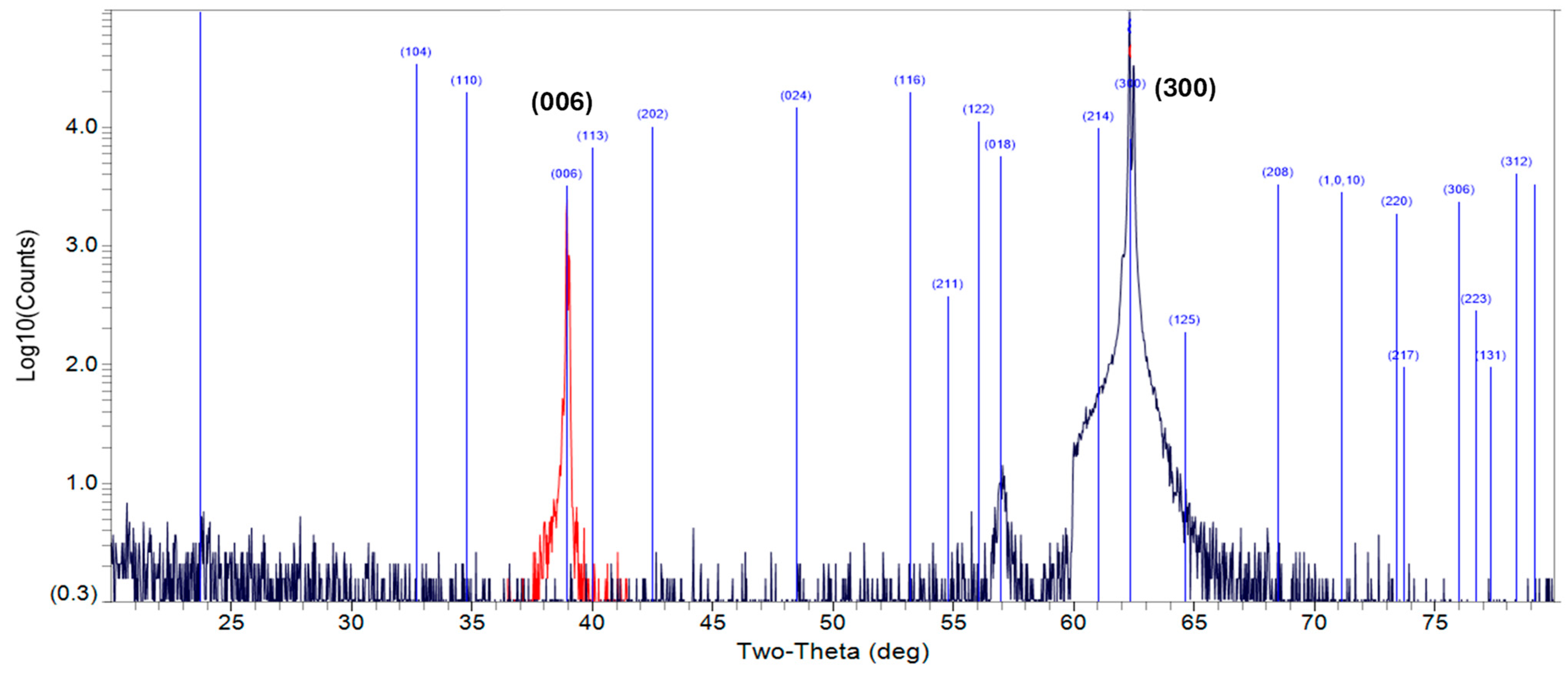
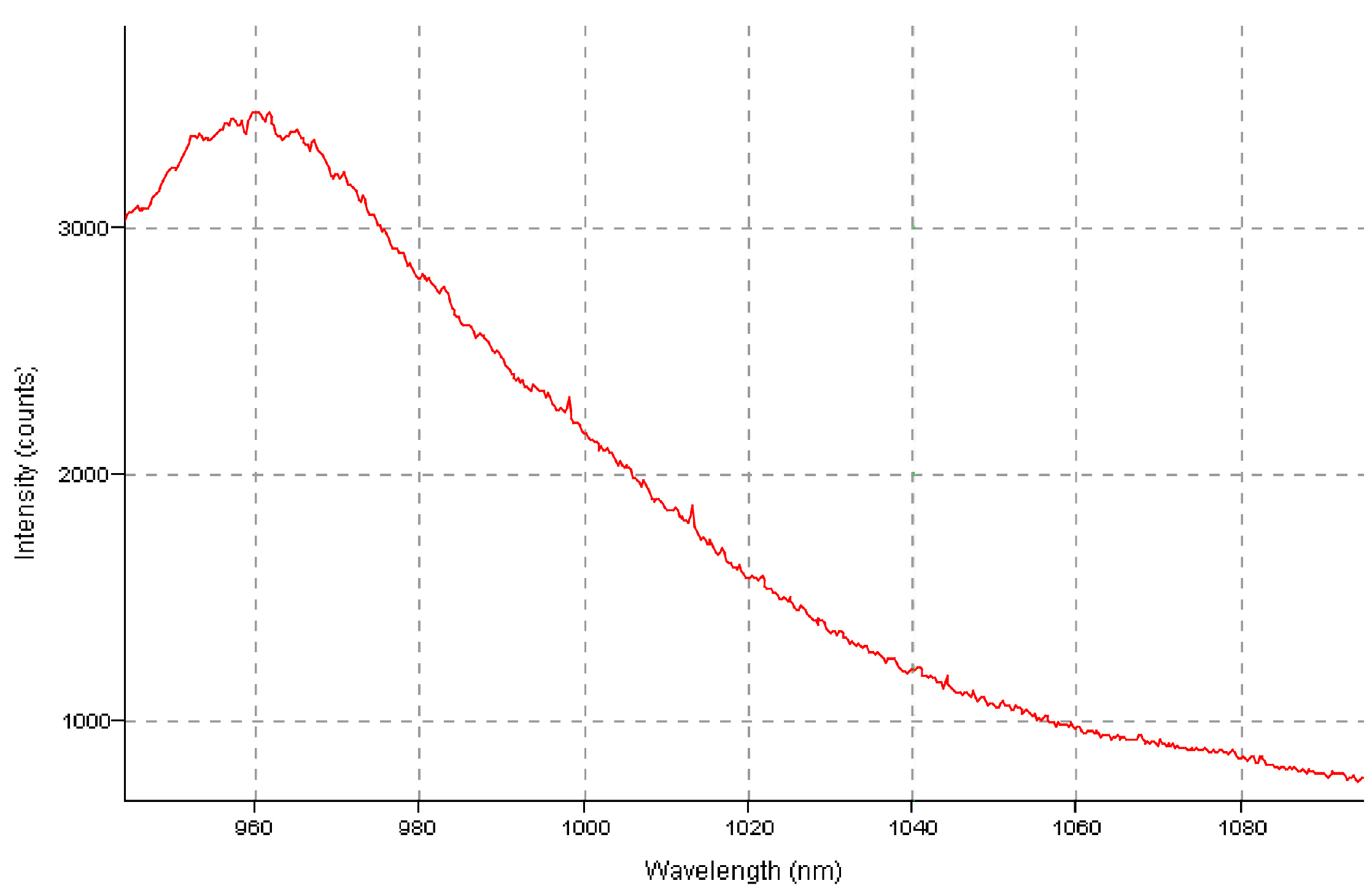

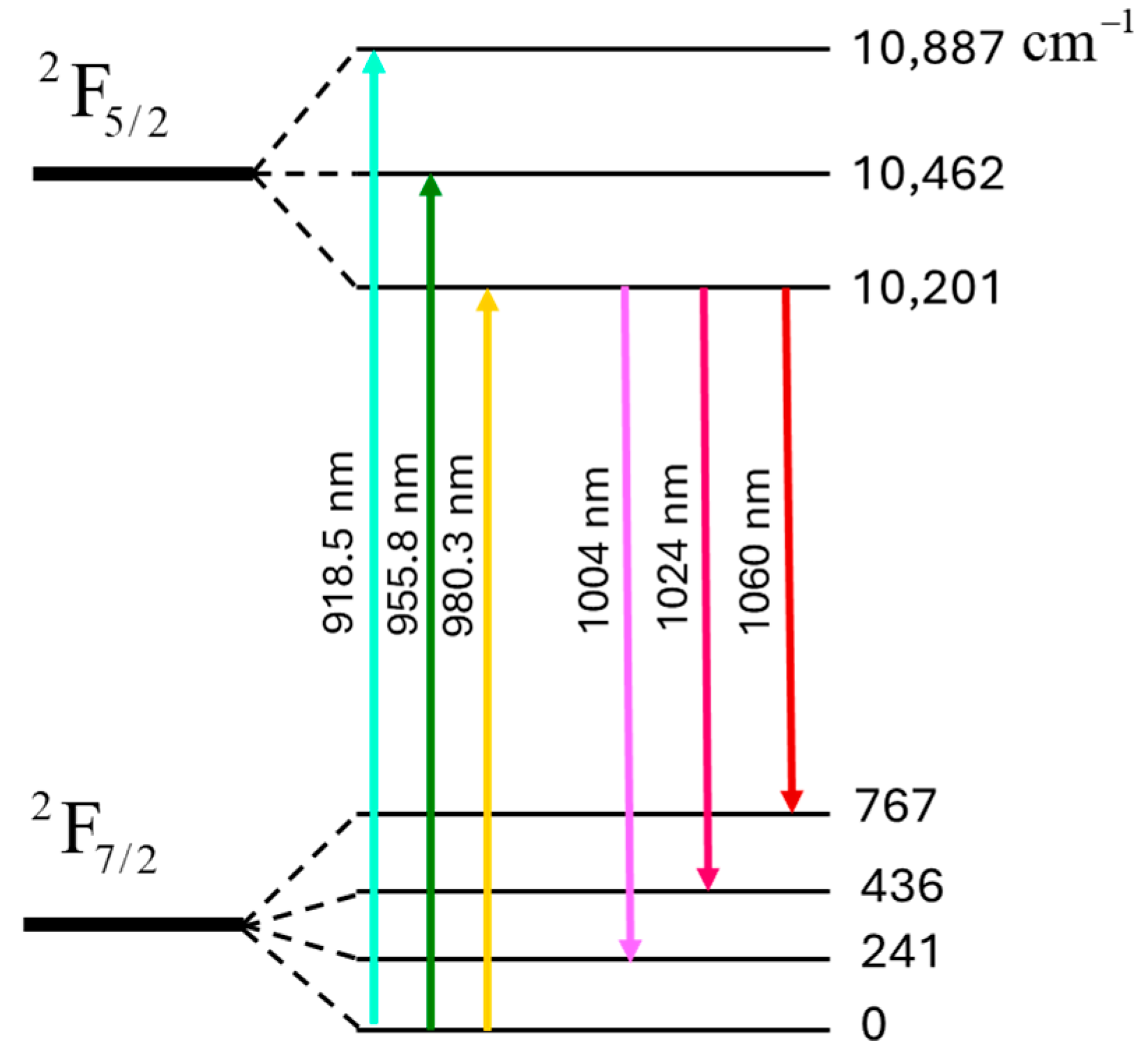
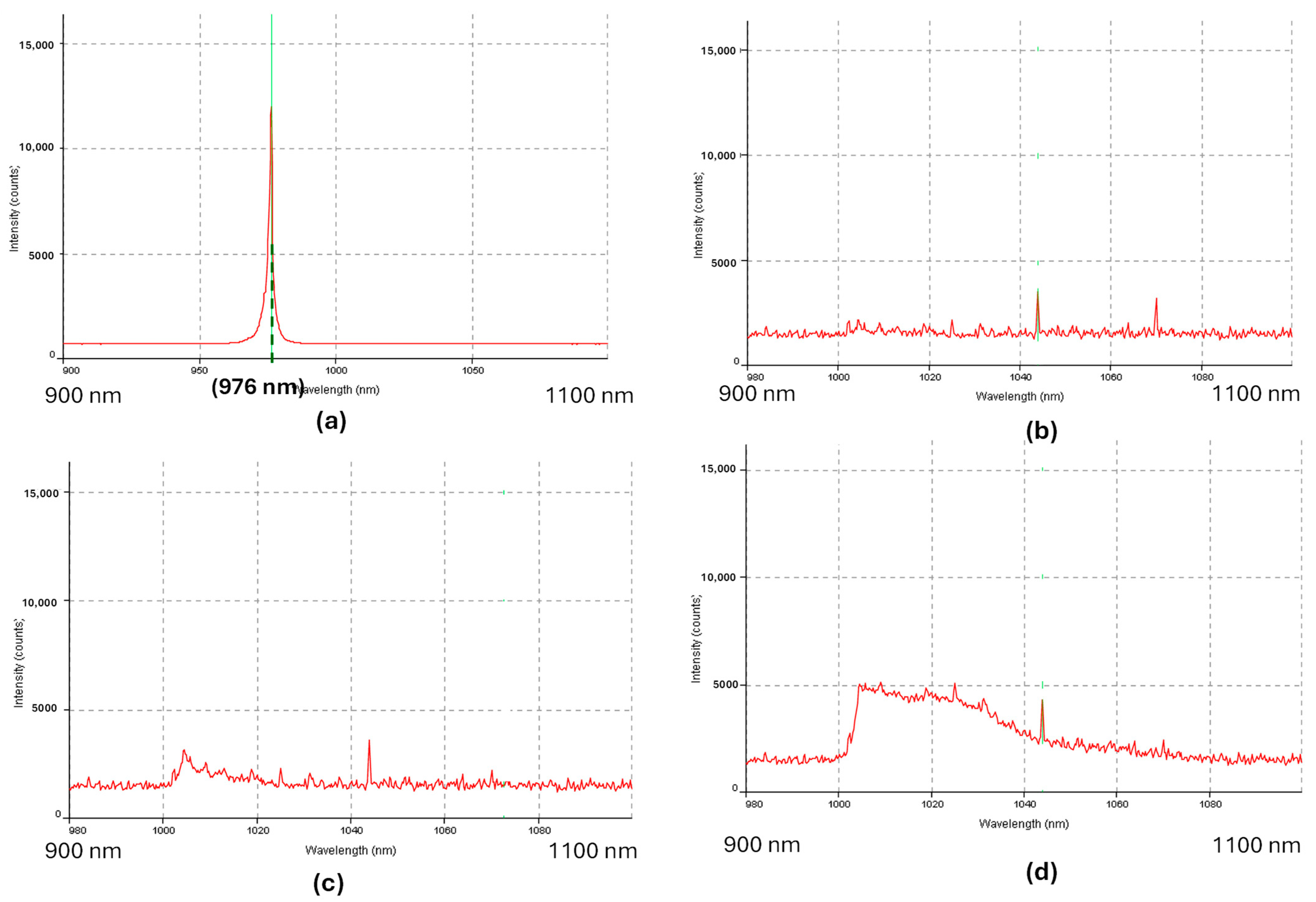

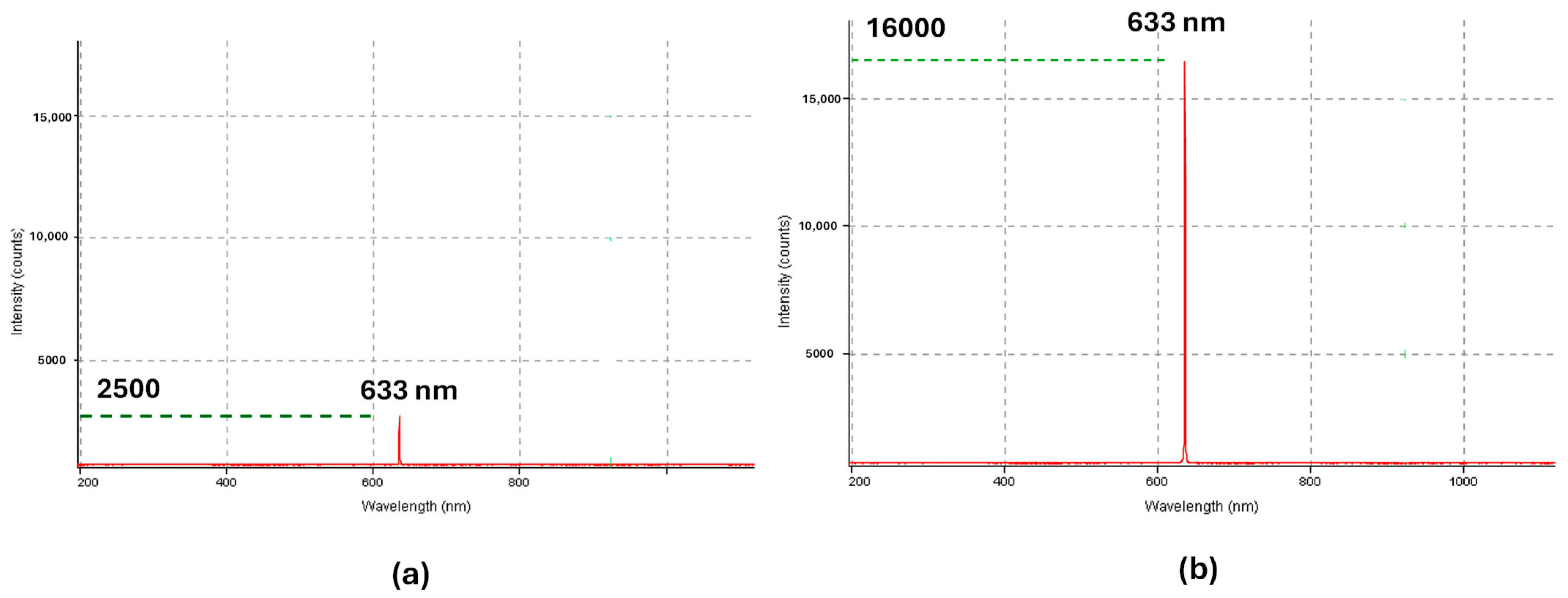
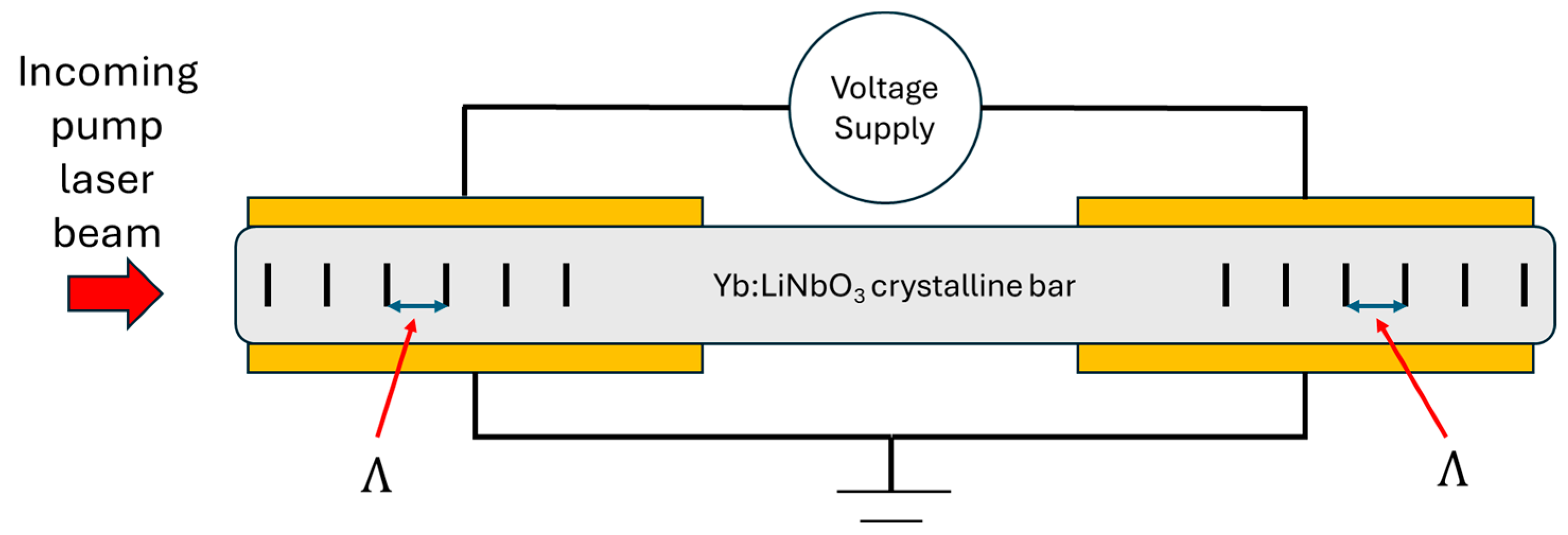
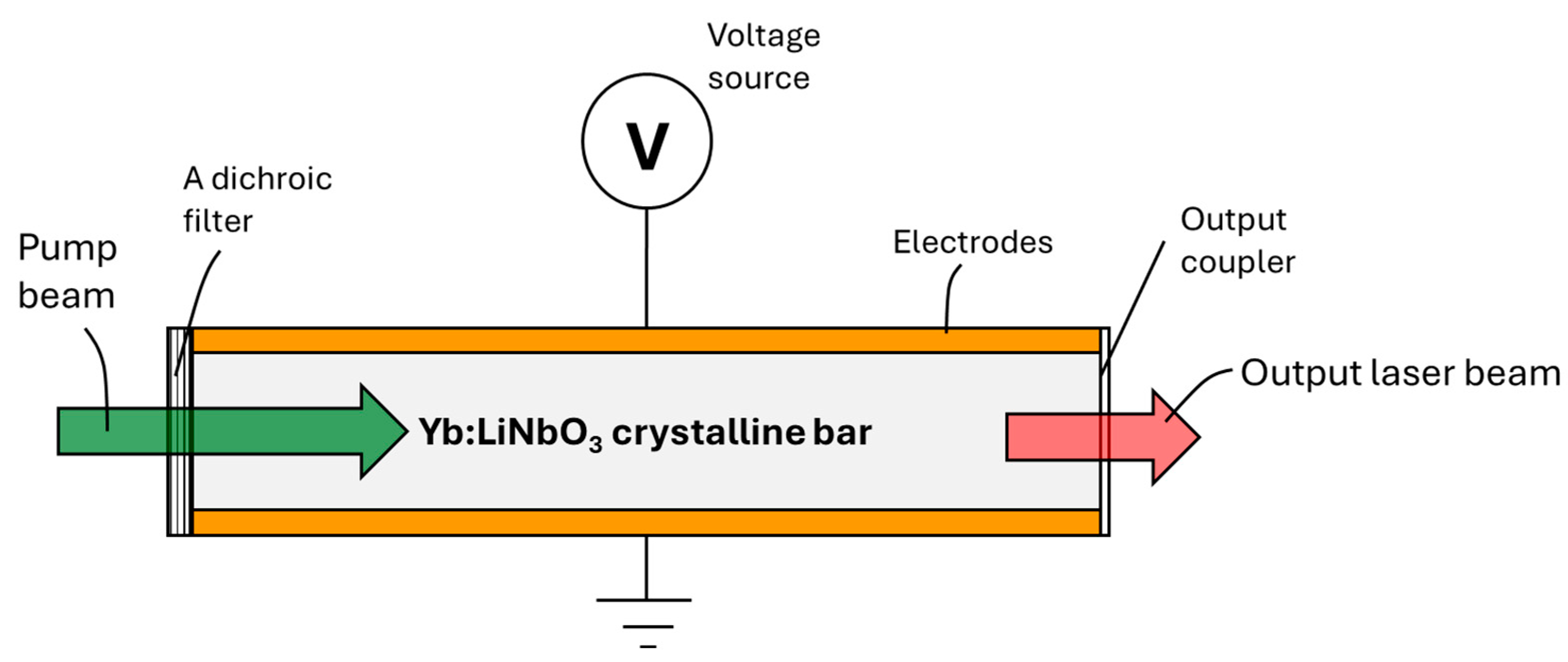
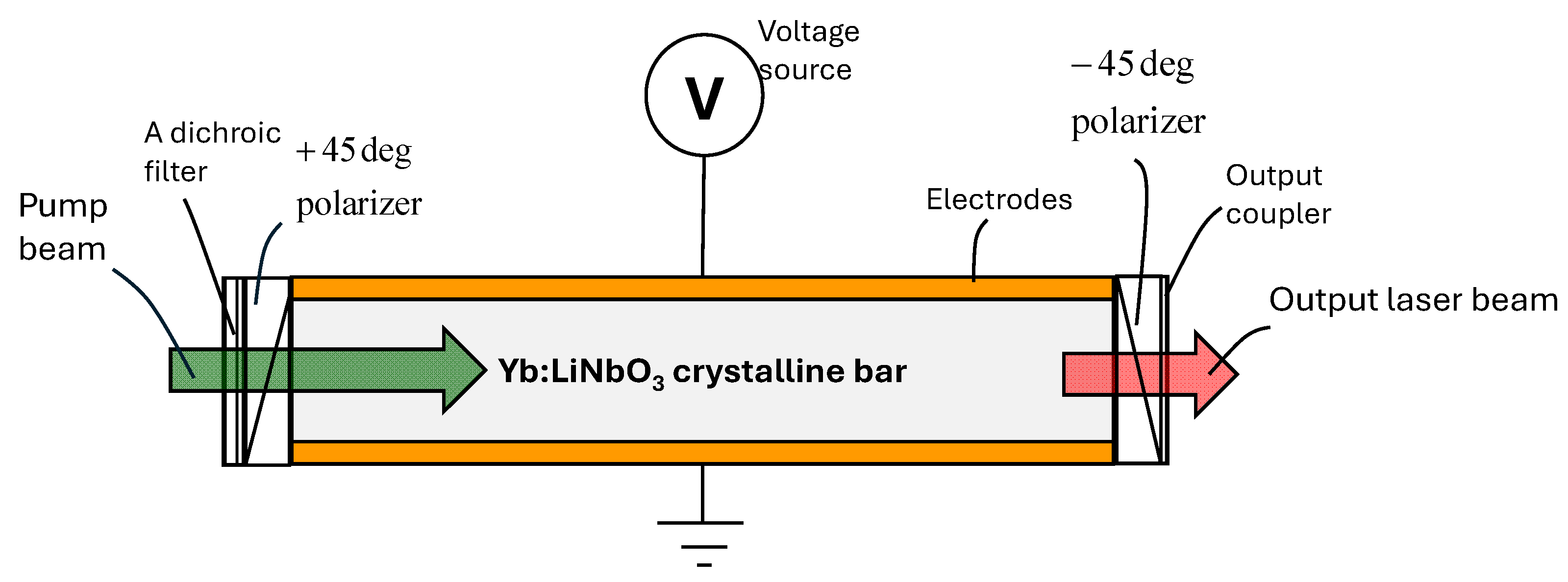
Disclaimer/Publisher’s Note: The statements, opinions and data contained in all publications are solely those of the individual author(s) and contributor(s) and not of MDPI and/or the editor(s). MDPI and/or the editor(s) disclaim responsibility for any injury to people or property resulting from any ideas, methods, instructions or products referred to in the content. |
© 2025 by the authors. Licensee MDPI, Basel, Switzerland. This article is an open access article distributed under the terms and conditions of the Creative Commons Attribution (CC BY) license (https://creativecommons.org/licenses/by/4.0/).
Share and Cite
Wu, K.; Kabir, M.A.; Chou, K.-t.; Yin, S. Growth and Characterization of High Doping Concentration (2.1 at%) Ytterbium (Yb) Doped Lithium Niobate (LiNbO3) Crystal: An Electrically Tunable Lasing Medium. Crystals 2025, 15, 486. https://doi.org/10.3390/cryst15050486
Wu K, Kabir MA, Chou K-t, Yin S. Growth and Characterization of High Doping Concentration (2.1 at%) Ytterbium (Yb) Doped Lithium Niobate (LiNbO3) Crystal: An Electrically Tunable Lasing Medium. Crystals. 2025; 15(5):486. https://doi.org/10.3390/cryst15050486
Chicago/Turabian StyleWu, Kaicheng, Mohammad Ahsanul Kabir, Kai-ting Chou, and Shizhuo Yin. 2025. "Growth and Characterization of High Doping Concentration (2.1 at%) Ytterbium (Yb) Doped Lithium Niobate (LiNbO3) Crystal: An Electrically Tunable Lasing Medium" Crystals 15, no. 5: 486. https://doi.org/10.3390/cryst15050486
APA StyleWu, K., Kabir, M. A., Chou, K.-t., & Yin, S. (2025). Growth and Characterization of High Doping Concentration (2.1 at%) Ytterbium (Yb) Doped Lithium Niobate (LiNbO3) Crystal: An Electrically Tunable Lasing Medium. Crystals, 15(5), 486. https://doi.org/10.3390/cryst15050486






